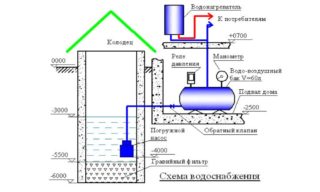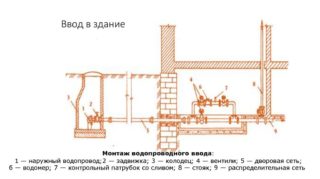In order for a cottage on a suburban area to be comfortable for living, it is important to bring water into the house from a well. It is more often used as an autonomous source in parallel with wells. Understanding the principles of completing the task, the master can do the work with his own hands, which will save the family's budget.
- Types of water supply organization of a private house from a well
- How to choose the type of water supply
- Plumbing design
- Tools and materials
- Installation and connection stages
- Earthworks
- Pipe laying
- Installation of pumping equipment
- Commissioning of pumping equipment
- backfilling
- Advantages and disadvantages of well water supply
Types of water supply organization of a private house from a well
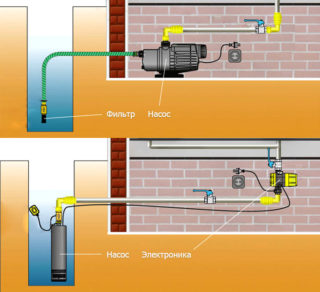
There are several ways to bring the line to the cottage from the source:
- Using submersible pumping equipment with a float switch. The unit operates in an aquatic environment, at a depth of 9 meters or more. This type of water supply is suitable for very long source shafts.
- Using a surface unit. The pump is installed in close proximity to the well, and its water intake hose is lowered below the level of the water mirror. Surface devices are capable of pumping liquid from a level up to 8-9 meters. When it is strengthened by a remote ejector, this indicator can be increased to 12-15 m.
- By means of a pumping station. Thanks to this type of equipment, an even pressure is constantly maintained in the system. In the event of a power outage, the family has a supply of water for 1-3 hours (depending on the volume of the tank). The system works on the principle of regular pumping of liquid into the accumulation membrane tank. The pump turns on when the pressure in the tank changes (outflow / inflow).
More often, craftsmen prefer to use a water supply scheme in a country house from a well with a hydraulic accumulator.
How to choose the type of water supply
You can determine the specific type of water supply from the well by the following parameters:
- Water mirror level in the source. It defines the type of pump to be used. If the distance to the liquid from the earth's surface is not more than 8 m, the best option is a surface pump or station. If the water level is located deeper, it is better to give preference to submersible equipment.
- The amount of water consumed. According to SNiP, there are about 200 liters per person per day. If a family of 3-4 people lives in the house permanently, it is advisable to equip the pump with a membrane tank. Thus, it is possible to provide all residents of the cottage with the required amount of resources. If there are two people in the house and you don't need a lot of water, you can do without a hydraulic accumulator.
- Distance from the well to the farthest plumbing point in the house. The larger it is, the more powerful you need to take the pump.
- Seasonality of living in a cottage. For a summer cottage, you can safely lay pipes along the top of the ground and equip a well with any type of pump. For the winter, all this is removed, the system is preserved. If the family lives outside the city all year round, you need to organize a full-fledged buried (winter) highway with a caisson and insulation.
When selecting submersible injection equipment, it is better to abandon the vibration pump. During its chaotic movement in the mine, it is capable of damaging concrete rings or masonry bricks. It is better to give preference to centrifugal models.
Plumbing design
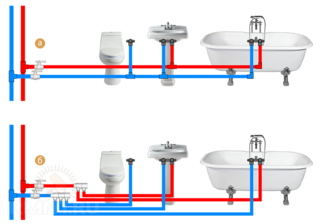
Before starting the installation work, it is necessary to draw up a detailed drawing of the laying-supply of the main and the installation of all points of the equipment. In this case, a water supply scheme for a private house from a well with a submersible pump or with a surface pump can be drawn up taking into account two types of pipe routing. They depend on the pressure in the system. There are such types of wiring:
- Consistent. It implies the laying of the main line and pipes of a smaller section extending from it to each plumbing point. If you open several taps at the same time with such a wiring, water will be supplied with a lower pressure.
- Collector. Here, a separate pipe is pulled to each plumbing point of the house. All of them are laid in parallel before entering the cottage. There, the wiring is already being done at the location of the intake point. The pressure in the taps with this type of installation of the line is stable. To reduce the consumption of pipes of the street part of the communication, a distribution manifold is installed in the house.
Collector piping is expensive, but it is a more convenient option in terms of constant water supply.
Tools and materials
- Pump (submersible or surface) of the required power.
- Hydraulic accumulator with a capacity of 25 liters or more.
- Coarse and fine filters.
- Fittings for connecting the water intake and outlet hoses.
- Check valves.
- Shut-off valves.
- The required footage of pipes. For an external water supply, it is better to take tubes from HDPE. The house can be fitted with plastic elements (PVC or polypropylene).
- Insulation for the external line.
- Pressure gauge and pressure switch.
In order not to independently assemble all the equipment into a single unit, you can buy a ready-made pumping station.
From the tools you need to prepare:
- shovel;
- plumbing tool;
- ramming;
- hacksaw;
- sealant;
- perforator with a crown for concrete;
- fittings for connecting internal pipes.
Work is best done in late summer or early autumn.
Installation and connection stages

All work on the water supply to the house in the country, in the village, in a suburban settlement is carried out in stages.
Earthworks
At this stage, a trench is excavated from the source to the entry of the highway into the house. It is important to lay pipes below the level of soil freezing. Therefore, a trench is dug 1.5-1.8 m deep. If this cannot be done due to the complexity of the relief, you will have to insulate the highway. Dig a trench to the very well. Here it is important to dig out the required number of concrete rings deep in order to make a technical hole for the pipe outlet.
The bottom of the trench is well compacted and a sand cushion is placed in it. She is also thoroughly rammed.
If a caisson is provided, a pit is dug under it in the trench section close to the well.
It remains to make a technical hole in the concrete ring with a perforator with a crown.
Pipe laying
It is better to enter the building through the foundation. The place where the tube is to be laid must be reinforced with a steel sleeve, the remaining gaps must be well sealed.
At the same stage, the caisson is mounted on a poured concrete base. The protective chamber can be made of bricks, concrete rings, monolithic fill. But this is laborious work.
Experienced mothers prefer to install a plastic caisson. This is a ready-made tank with an upper protective hatch, into which the line can be brought in and out from the sides.
Installation of pumping equipment
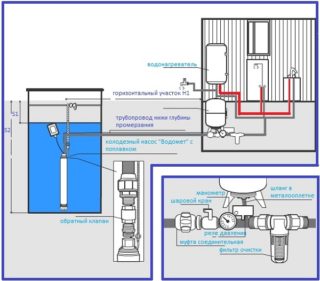
The injection unit is mounted. If it is a submersible pump, proceed as follows:
- A water supply hose of the required length is attached to the outlet pipe. It must reach the well adapter accurately from the bottom of the source (where the pump is located).
- The unit cable and the safety cable are pulled parallel to the pipe. The pump is carefully lowered into the well.
- The pipe is connected to the inside of the adapter. Then this part is carefully inserted into the technical opening of the concrete shaft ring and connected to the outside of the adapter. Everything is well sealed.
- A hose is supplied to the outer part of the adapter, which is connected to the accumulator in the caisson. The outlet hose from the tank is equipped with a non-return valve.
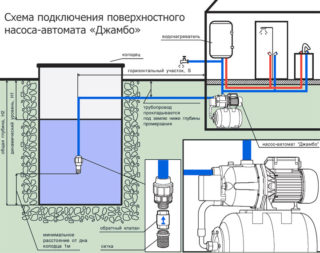
If the master uses a surface pump, work is performed in the following sequence:
- The unit is installed in a caisson, its legs are securely fixed to the floor of the chamber.
- A piece of HDPE pipe is laid from the inlet pipe of the pump using a union to the outer part of the adapter. Two elements are joined.
- Calculate the length of the pipe from the inside of the adapter to the point of its maximum immersion. The element is cut off and joined to the inner part of the adapter. It is then inserted into the technical hole of the concrete ring and firmly connected to the outer part. The end of the intake tube, located in the water, is equipped with a coarse filter.
- A piece of hose is pulled from the outlet of the installed pump to the accumulator. One check valve is mounted on this section. The second one is placed on the water supply pipe in the source shaft. The third is after the accumulator.
All joints and connections are well coated with silicone sealant.
Commissioning of pumping equipment
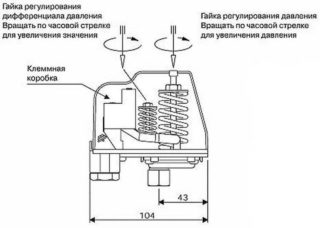
The surface pump and accumulator must not be connected dry. Therefore, initially, water is poured into them through special technical holes.
When starting the station for the first time, you need to adjust the optimal pressure indicators. The minimum normal is 1.5 atm. Upper - 3.5 atm. With these parameters, the pump will turn on and off independently.
Debugging of pressure boundaries is performed using special handles. The course of their movement is shown by arrows.
A perfectly tuned station supplies / pumps up water without interruption.
backfilling
If all sections of the pipeline are assembled correctly, docked tightly, the main wiring system does not leak, you can backfill the line and the caisson. It is desirable to protect the pipes with polystyrene foam cylinders from freezing and mechanical action of the soil.
Backfilling of the line is performed without soil compaction. The soil around the caisson and shaft rings must be compacted in layers. Professionals recommend sprinkling the tanks with a cement-sand mixture. So the caisson and the shaft rings will stand motionless.
Advantages and disadvantages of well water supply
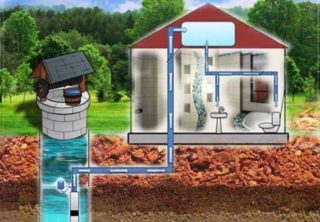
The main advantages of supplying water from a well include:
- The ability to make a simple village water supply without the use of complex equipment.
- Relative ease of installation of the line.
- Lower costs for the installation of the line in comparison with the installation of a borehole water supply.
- No need to obtain a license for the source in order to further conduct a highway from it to the house.
- The service life of the well is about 15-20 years.
Of the minuses of such a water supply device, there are:
- Lack of pressure in the absence of a hydraulic accumulator.
- Possibility of small debris falling into the well, clogging of the pump.
- There is a risk of the unit running idle if the water mirror drops sharply. Especially during hot seasons.
Each master independently weighs for himself the pros and cons of conducting well water supply, depending on the technical parameters of the source.
If we consider the cost of supplying water to the house from a well from a contractor, the master will have to pay about 70-95 thousand rubles. When laying and arranging a highway with your own hands, the costs are equal to 45-60 thousand rubles. The most expensive piece of equipment is a pump and a hydraulic accumulator for it. The final cost will depend on the price of the selected models and on the required pipe footage.

